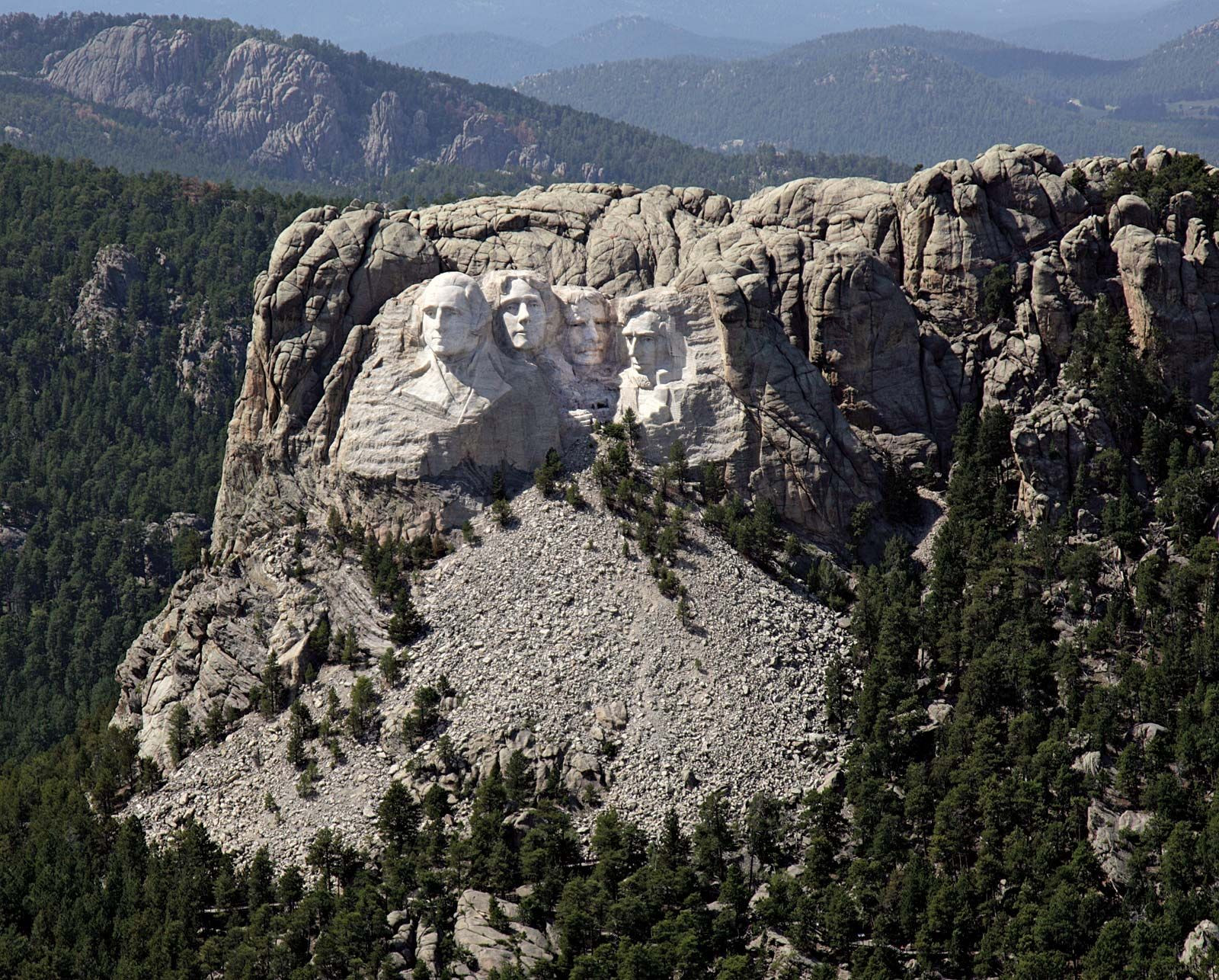Mount Rushmore National Memorial stands as a colossal testament to American history and artistry. Carved into the granite face of Mount Rushmore in the Black Hills of South Dakota, this iconic sculpture depicts the 60-foot (18-meter) faces of four prominent United States presidents: George Washington, Thomas Jefferson, Theodore Roosevelt, and Abraham Lincoln. But where is Mount Rushmore located exactly?
Mount Rushmore is situated in southwestern South Dakota, approximately 25 miles (40 kilometers) southwest of Rapid City. For those navigating to this monumental landmark, it is positioned about 10 miles (16 kilometers) northeast of Custer and lies just north of the expansive Custer State Park. The mountain itself, originally named after New York lawyer Charles E. Rushmore in 1885, reaches an elevation of 5,725 feet (1,745 meters) and provides a dramatic canvas for this national treasure. Administratively, the Mount Rushmore National Memorial, encompassing 2 square miles (5 square km), falls under the stewardship of the U.S. National Park Service (NPS), which has managed the site since 1933.
The Genesis of a Monument: Crafting Mount Rushmore
The concept of a grand sculpture in the Black Hills emerged in 1923 from South Dakota state historian Doane Robinson. Initially, Robinson imagined depicting notable Native American figures and icons of the American Old West on the unique needle-like rock formations within Custer State Park. However, when sculptor Gutzon Borglum was commissioned to design and execute the project, he deemed the Custer State Park site unsuitable due to unstable and eroded rock. Borglum instead selected nearby Mount Rushmore, prized for its robust granite face.
Borglum’s vision extended beyond mere portraiture. He proposed that the four presidential figures would symbolize the first 150 years of the United States. George Washington was chosen to represent the nation’s founding, Thomas Jefferson for its territorial expansion, Theodore Roosevelt to signify its development as both a domestic and global power, and Abraham Lincoln to embody its preservation through the Civil War.
Work commenced on the Mount Rushmore memorial in October 1927, shortly after its dedication by President Calvin Coolidge. Construction spanned 14 years, encountering interruptions due to funding constraints, design revisions—most notably the relocation of Jefferson’s likeness—and the passing of Gutzon Borglum in March 1941. His son, Lincoln Borglum, assumed leadership of the project, overseeing its completion in October 1941. The carving process itself involved six and a half years of dedicated labor by hundreds of workers. They employed techniques ranging from dynamite blasting to jackhammers, chisels, and drills to sculpt the immense granite figures. Approximately 450,000 tons of rock were removed, much of which remains at the base of the memorial. The project, largely funded by the federal government with supplemental private donations, amounted to nearly $1 million. The heads were individually dedicated over several years: Washington in 1930, Jefferson in 1936, Lincoln in 1937, and Roosevelt in 1939.
Mount Rushmore Today: An Enduring Symbol
Mount Rushmore has transcended its physical location to become an instantly recognizable symbol of the United States. It ranks among the most frequented National Park Service sites and stands as a premier tourist destination in the country, attracting over two million visitors annually. To accommodate this influx, the memorial’s infrastructure has been continuously enhanced.
Significant improvements include the Avenue of Flags, inaugurated in 1976, which provides aProcession walkway towards the mountain adorned with flags representing the 56 U.S. states and territories. A comprehensive renovation completed in 1998 introduced the Grand View Terrace and its amphitheater, offering panoramic views of the monument, the Presidential Trail for closer perspectives, and the Lincoln Borglum Museum, showcasing the memorial’s history. Visitors can also explore the Sculptor’s Studio (1939), exhibiting original tools and the scale model used in the carving process.
 Aerial view of Mount Rushmore and its colossal sculpture set within the Black Hills, southwestern South Dakota, U.S.
Aerial view of Mount Rushmore and its colossal sculpture set within the Black Hills, southwestern South Dakota, U.S.
Nestled within the Black Hills National Forest, Mount Rushmore is surrounded by natural beauty. Ponderosa pines dominate the landscape, interspersed with aspen groves. The area supports diverse wildlife, including mountain goats, mule deer, bison, elk, and pumas, alongside smaller mammals and various bird species. Beyond Mount Rushmore, nearby attractions include Custer State Park, Wind Cave National Park, Crazy Horse Memorial, and Jewel Cave National Monument, offering a rich tapestry of natural and cultural experiences in the vicinity of this monumental sculpture in South Dakota. While visiting Mount Rushmore, travelers will find convenient road access, dining options, and a visitor center, though overnight accommodations are not available directly at the memorial site.
